The Premier League has become a major reference in football analysis due to its abundance of high-level coaches and players, making it a hub for those seeking to learn from coaches worldwide.
One of the areas where the Premier League currently leads globally is set-pieces, where it has made significant strides in all types of set plays in recent years.
It is known that there are three methods of defending corner kicks:
- Man-marking system: This method relies on marking players individually, with only one or more players designated as zonal defenders.
- Zonal-marking system: This method relies entirely on defending specific zones. Each player stands in a designated area, awaiting the ball to strike if it enters his zone.
- Hybrid system: Currently predominant, this method involves a combination of zonal defenders and man markers to effectively cover different areas and players.
In recent years, there has been a noticeable scarcity in the Premier League’s use of a man-marking system, contrasting sharply with most, if not all, other leagues.
In the previous season, only three teams out of the total 20 in the competition adopted a man-marking system: Sheffield United, Nottingham Forest, and Crystal Palace.
It is also noteworthy that these teams altered their defensive approach during the season, transitioning to more zonal defenders by its conclusion, except for Sheffield United, who finished last.
Note: The number of zonal defenders in the man-marking system may vary, but in this study, we refer to teams employing only two zonal defenders or fewer, indicating a predominant reliance on man-marking.
Additionally, some teams initially used three zonal defenders, but many of them also increased their numbers by the end of the season, such as Newcastle United and Aston Villa.
As an indicator, Man City and Fulham, who do not employ man-marking, are the teams that conceded the fewest goals from corners, with a total of three goals each.
In contrast, Nottingham Forest, who still follow the traditional man-marking, conceded the highest number of goals from corners in the previous Premier League season, totalling 15.
You may say well, but Man City and Fulham likely faced significantly fewer corner kicks than Nottingham Forest, so I bring you the percentages of goals conceded from corner kicks relative to the total number of corners faced for each of them:
- Fulham conceded three goals from 188 corners, a percentage of approximately 1.6%.
- Man City conceded three goals from 129 corners, a percentage of around 2.3%.
- Nottingham Forest conceded 15 goals from 245 corners, resulting in a percentage of 6.1%.
We do not argue that simply choosing a defensive system is everything.
What matters most are the clear roles of players and their understanding of how to react effectively to different scenarios.
It’s possible to find a team defending poorly with a hybrid approach or one using zone defence but failing to instruct players how to deal with diverse offensive actions.
However, we emphasise that several tactics have emerged that have effectively countered the man-marking system, leading many teams to change their systems and making us wonder whether it is on the path to extinction.
This is what we will further discuss in this tactical analysis.
Orientation problems in Man-Marking
As we know, this system doesn’t have enough zonal defenders to defend important areas.
Each marker has his opponent as a reference, so attacking teams can manipulate them easily, dragging most of them wherever they want, far away from the targeted area.
Making the targeted player escape or overcome his marker is crucial, and this is what we will mainly talk about.
We will discuss the main ideas that cause issues for the man markers, which can be designed by hundreds of routines.
The first issue is causing orientation problems to the targeted player’s man marker, meaning that doing some actions and movements makes him unable to keep tracking the ball and the targeted player at the same time.
Moreover, the targeted player can just drag his marker into a difficult position, making it difficult for him to track him and the ball at the same time.
Let’s explain with examples!
Starting with Arsenal’s last game against Crystal Palace, in which the Gunners could score twice from corners, you can see below the man-marking system using only two zonal defenders on the near post and the middle, so Arsenal decides to target this large area behind the second one, so they simply use two attackers to make them out of the game.
In yellow, one of them moves in front of the two zonal defenders, taking their attention, stopping in front of the first one while the one in orange blocks the second zonal defender from his back, preventing him from stepping back to the targeted area.
Ben White does his usual job by standing close to the goalkeeper to block him, preventing him from claiming the ball.
We should mention that he does that excellently with different strategies during the season.
The player in white just drags his marker away, also to take the zonal defenders’ attention and help frame the goal to be ready for any second ball.
Easily and finally, the rest is the targeted player’s job.
Gabriel Magalhães, in baby blue, starts in the middle and steps one step toward the near post and then moves toward the far post in a critical feint.
It’s worth mentioning that Arsenal left two players for the rebound and a player to cover them.
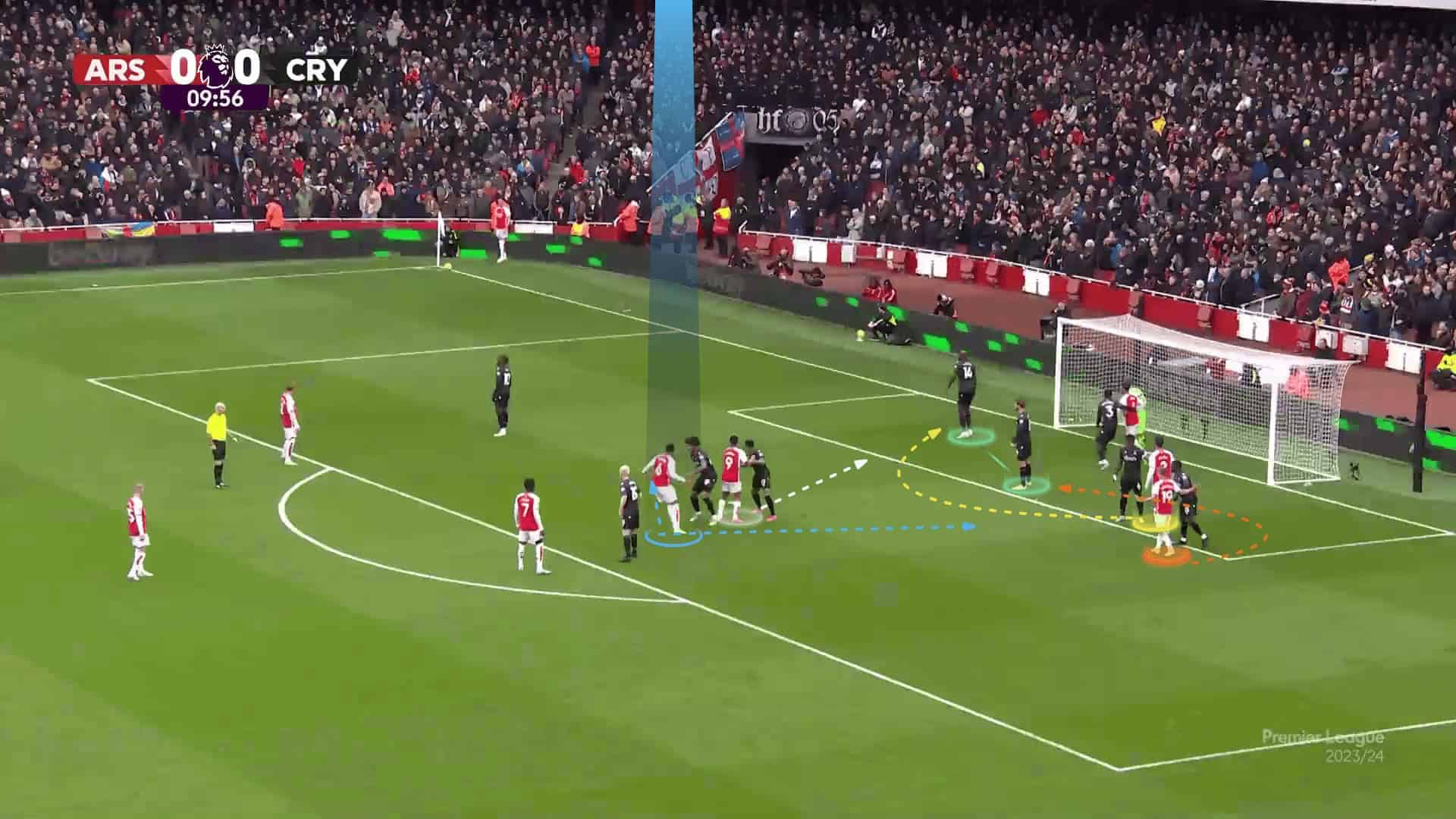
This feint toward the far post means that the marker can’t face the ball to track it and Gabriel at the same time, meaning that he should choose either to keep facing the ball, letting Gabriel escape, or turn around, giving his back to the ball, to track Gabriel.
This is what will happen.
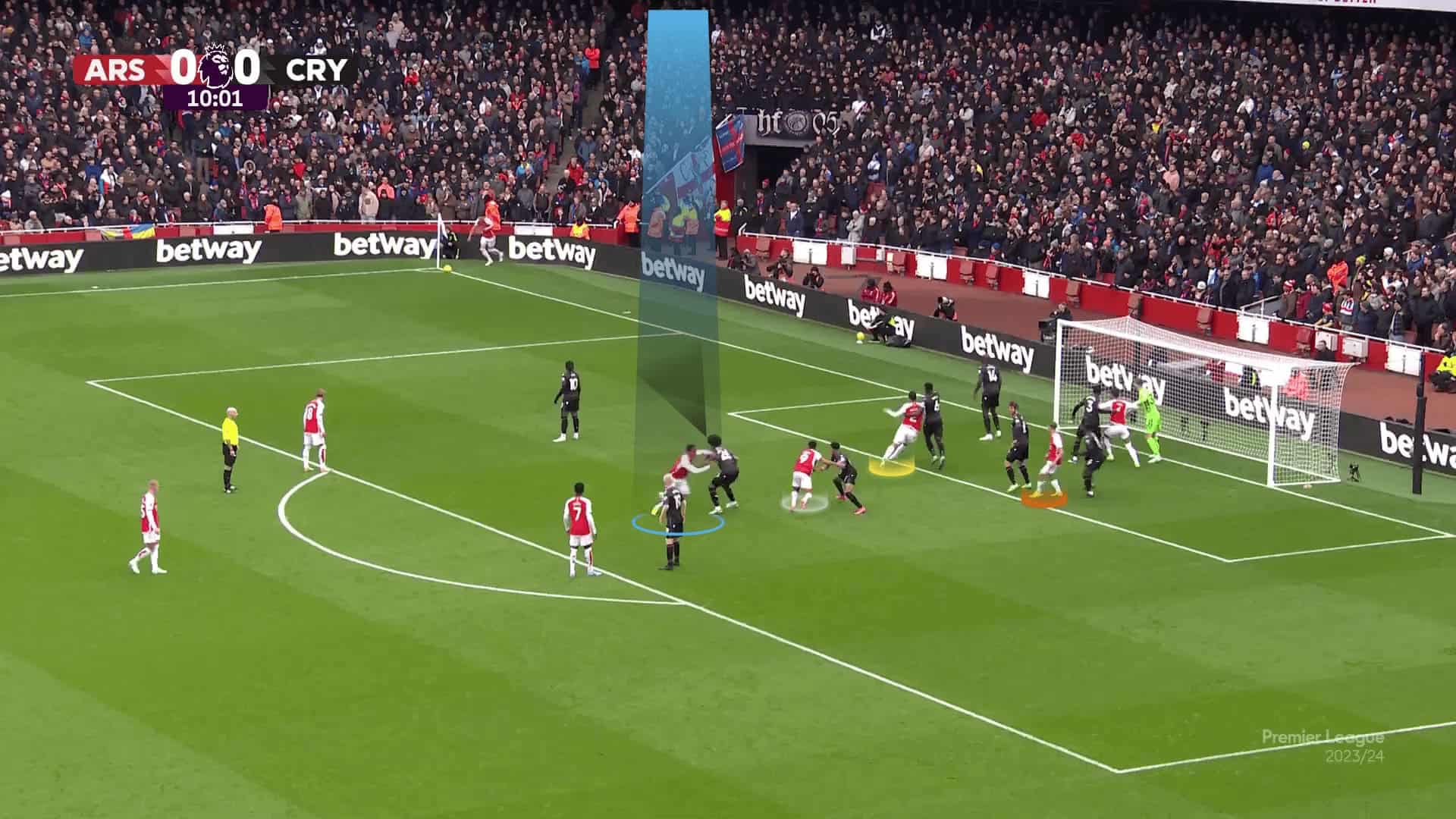
The marker chooses the second choice, losing contact with the ball, but there is another strange thing in the photo below! Kai Havertz comes from outside the shot to be the second targeted player in case the ball passes Gabriel, and we will discuss that later in detail.
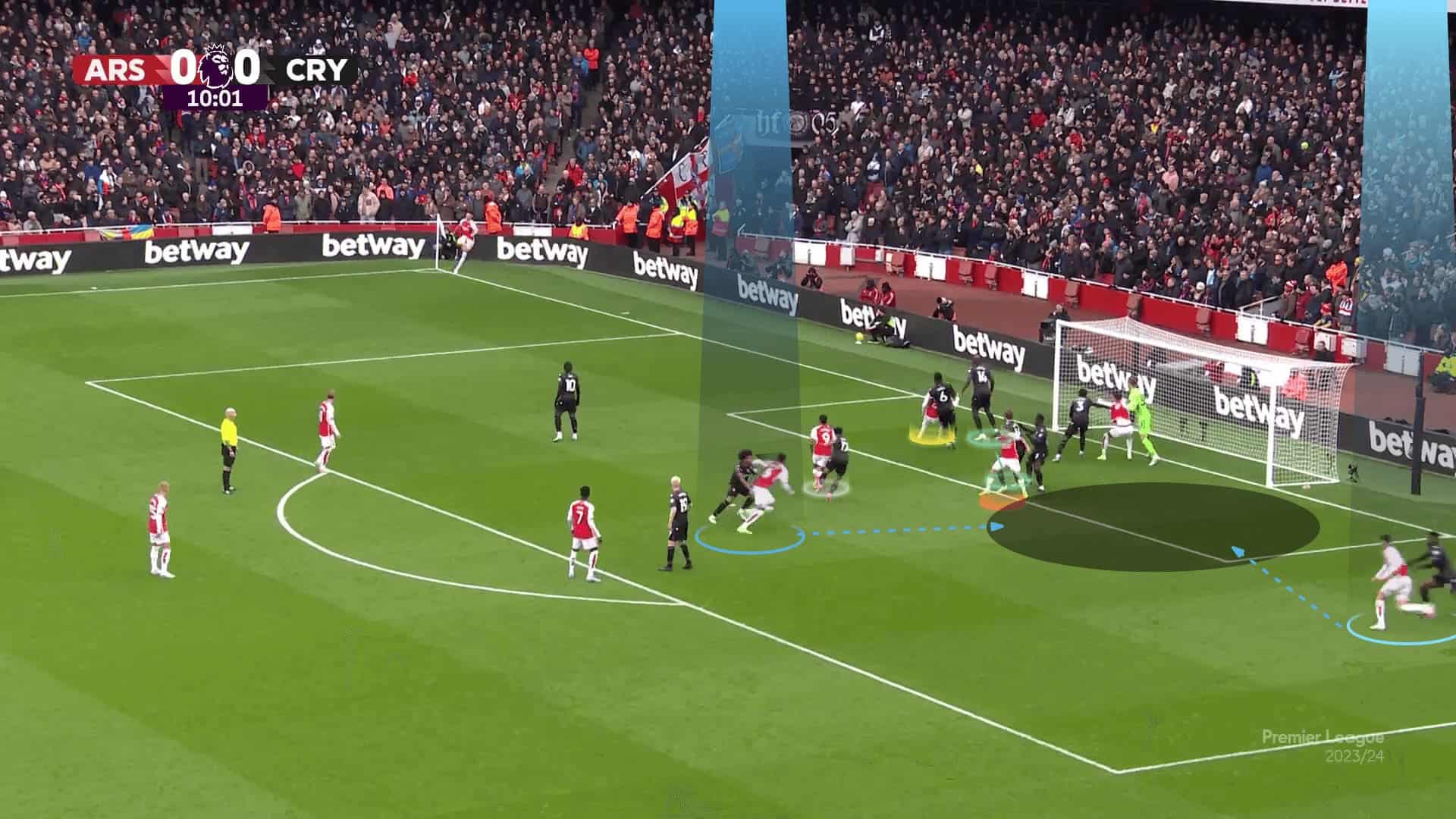
Below, Gabriel’s marker decides to take a look at the ball, and here he loses Gabriel, allowing him to win only a moment before him because of the orientation problem we discussed.
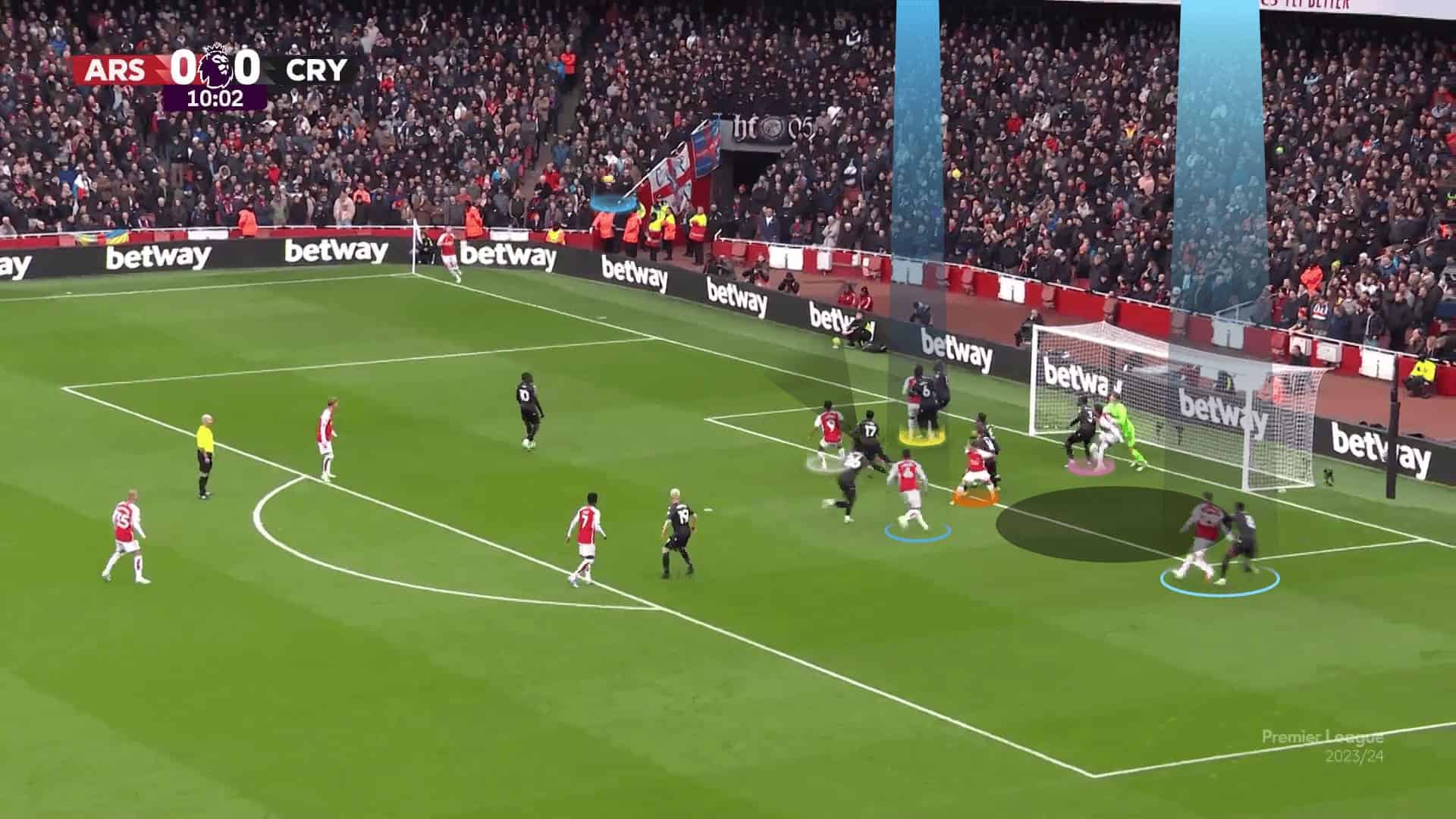
The plan works, and the result is a goal.
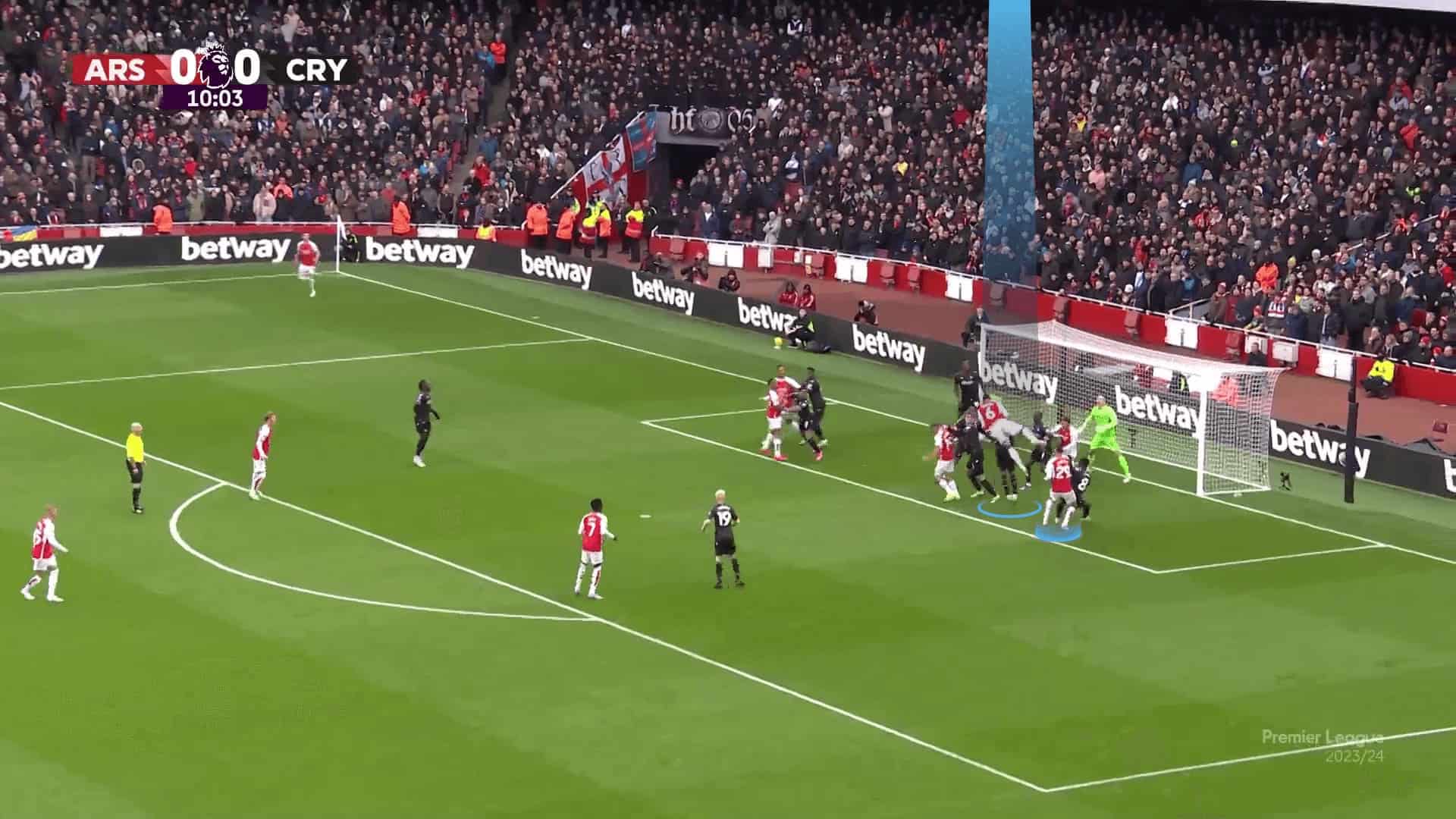
Coming back to Havertz’s weird starting position, he stands in the position below, which forces his marker to be at a difficult angle, giving his back to the ball.
He can also use the same principle to overcome him or win a moment before him with this curved run, as shown in the two photos below.
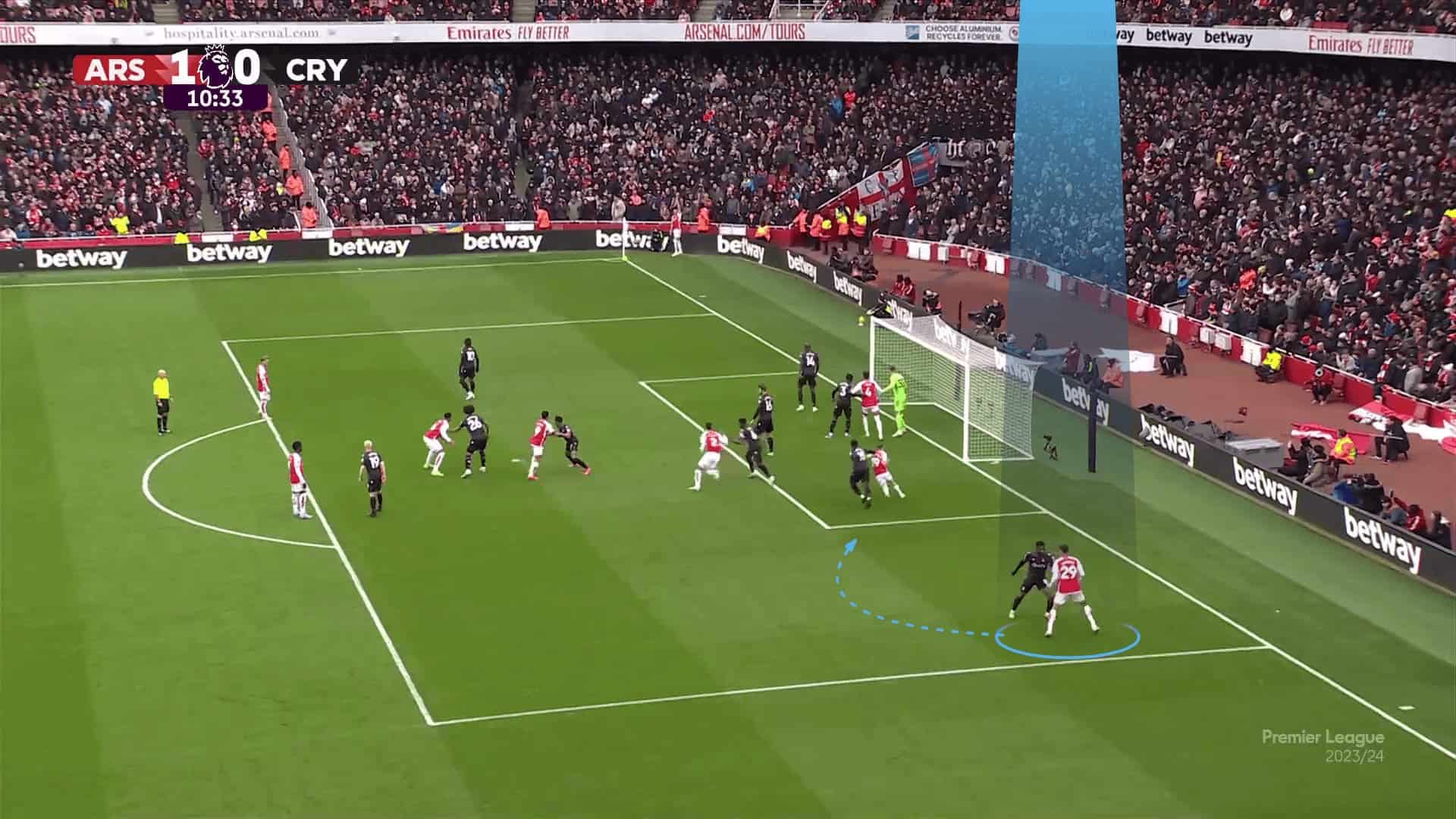
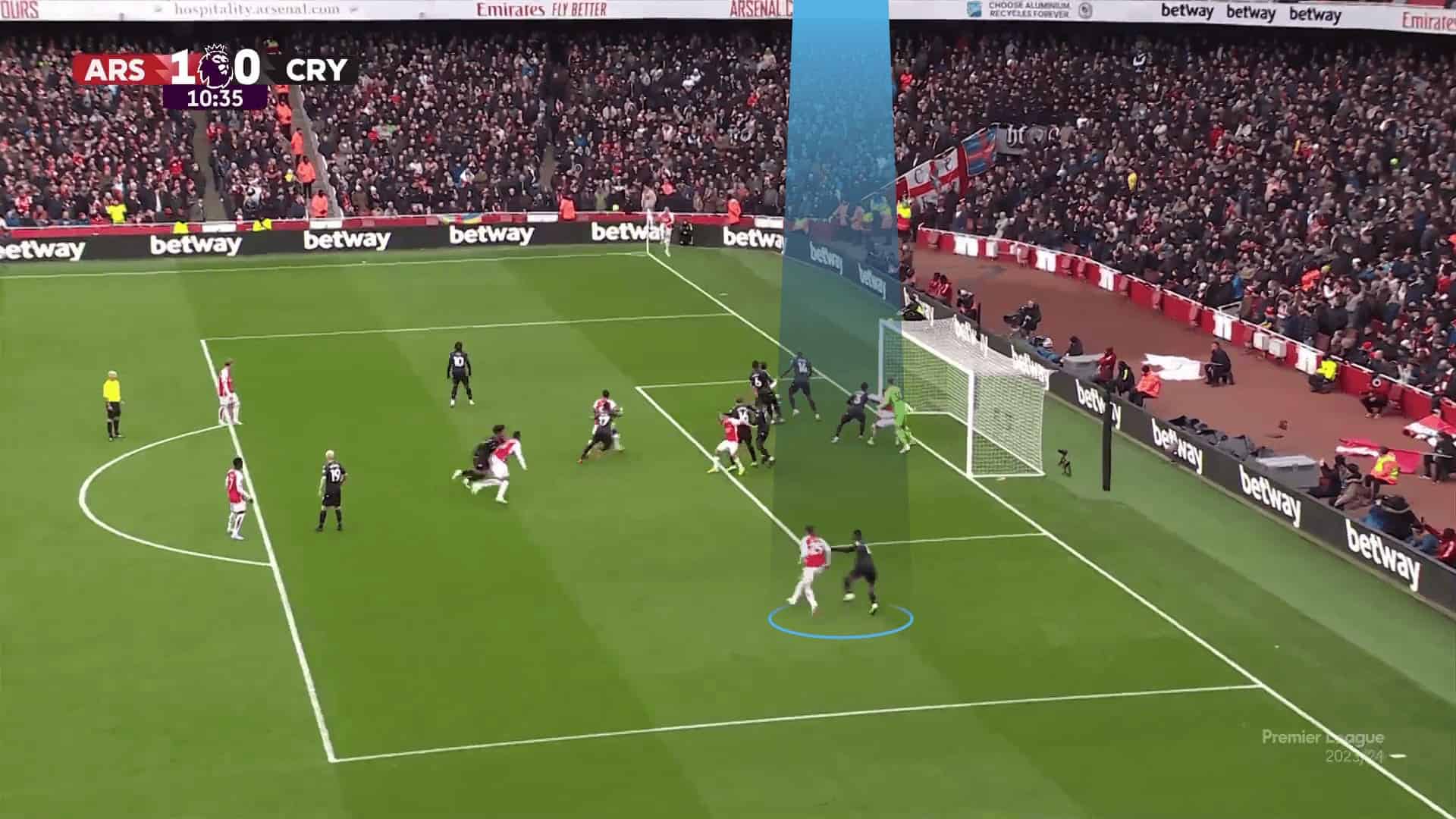
This position puts the marker against a difficult question to face: Havertz giving his back to the ball, making his priority only to slow him down, but this isn’t enough because there isn’t a zonal defender to cover him at the end, as in the previous case, or stand in the usual optimum zonal position trying to track the attacker and the ball at the same time, as in the case below.
This option opens the goalmouth for the attacker, like he says, welcome to the goal, while a mate in yellow can block him from his back when he turns around, as shown in the two photos below.
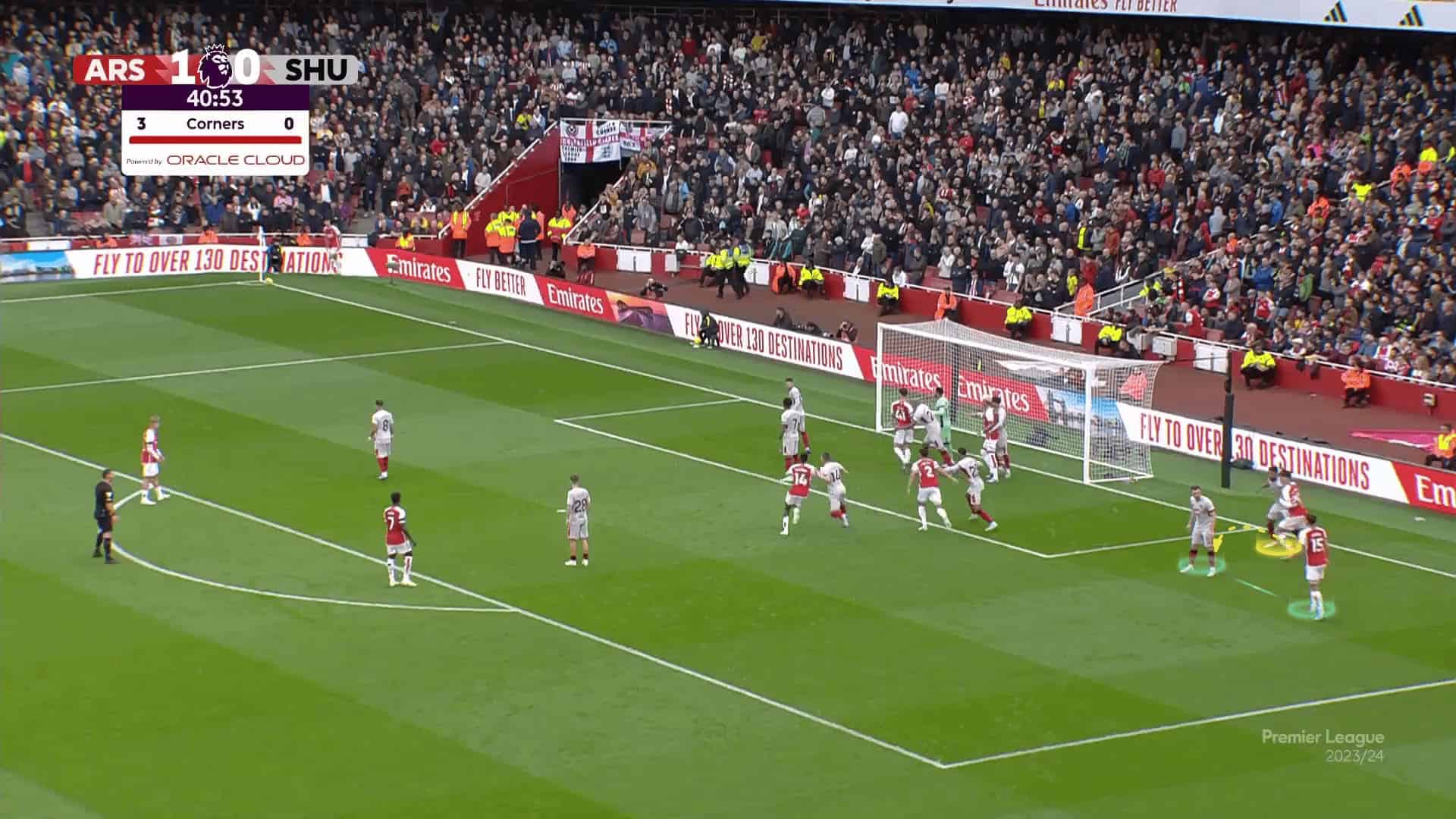
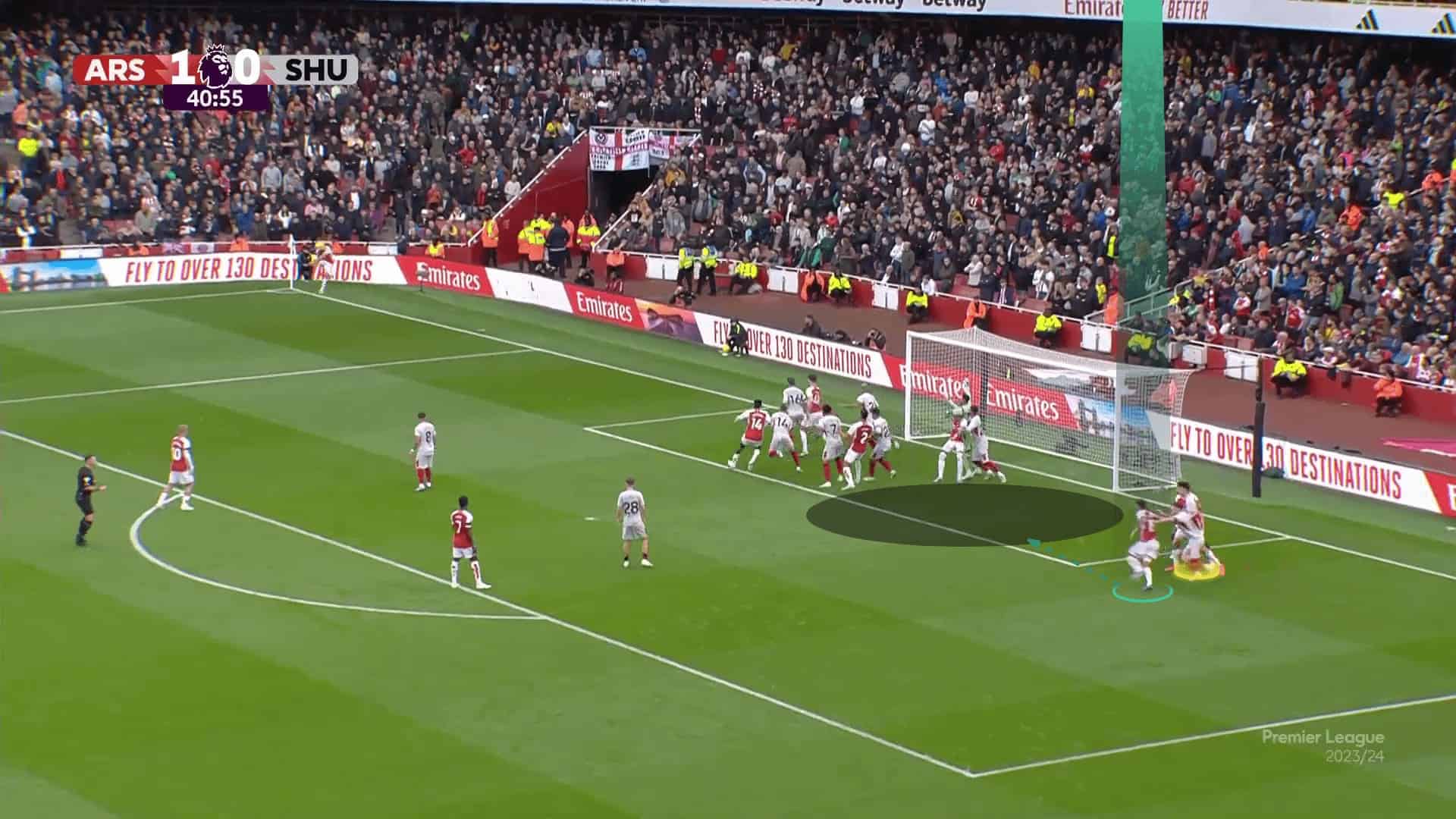
A mate blocks the targeted player’s marker, which is called a screen, as in basketball, and this makes us move to the next idea.
Screens: Disrupting Man-Marking Defenders
The second issue is using screens to make the targeted player escape from his marker, exploiting some movements and starting positions.
For example, you can see below three of Man City’s players standing in a pack while Rodri is the targeted player.
He will move around his mates in a curved path with the help of his yellow mate, who goes to block Rodri’s targeted player.
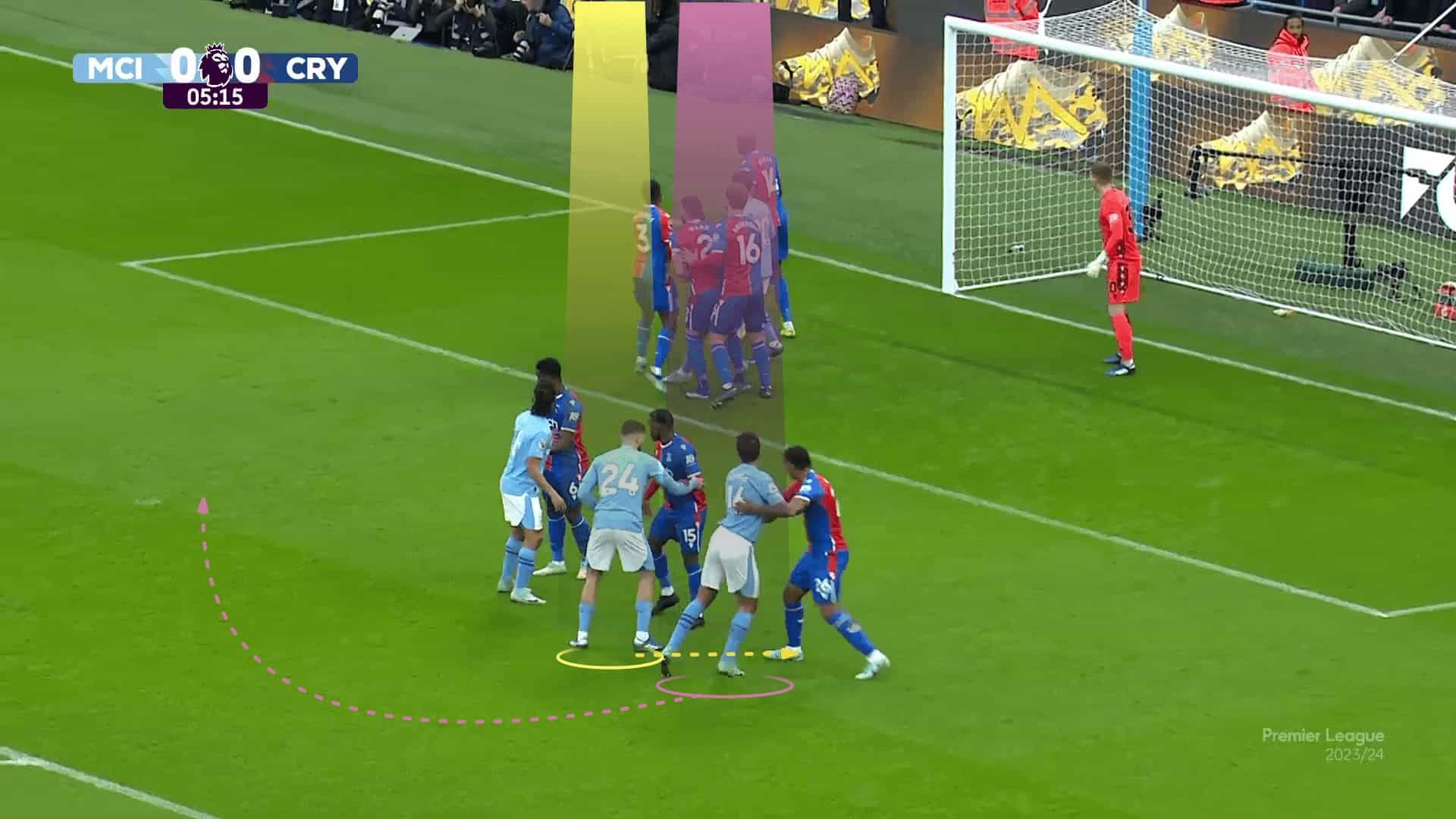
As in the two photos below, the screen is done perfectly while their third mate, in green, blocks his marker, making sure that he won’t leave him to go to Rodri when he realises the trick.
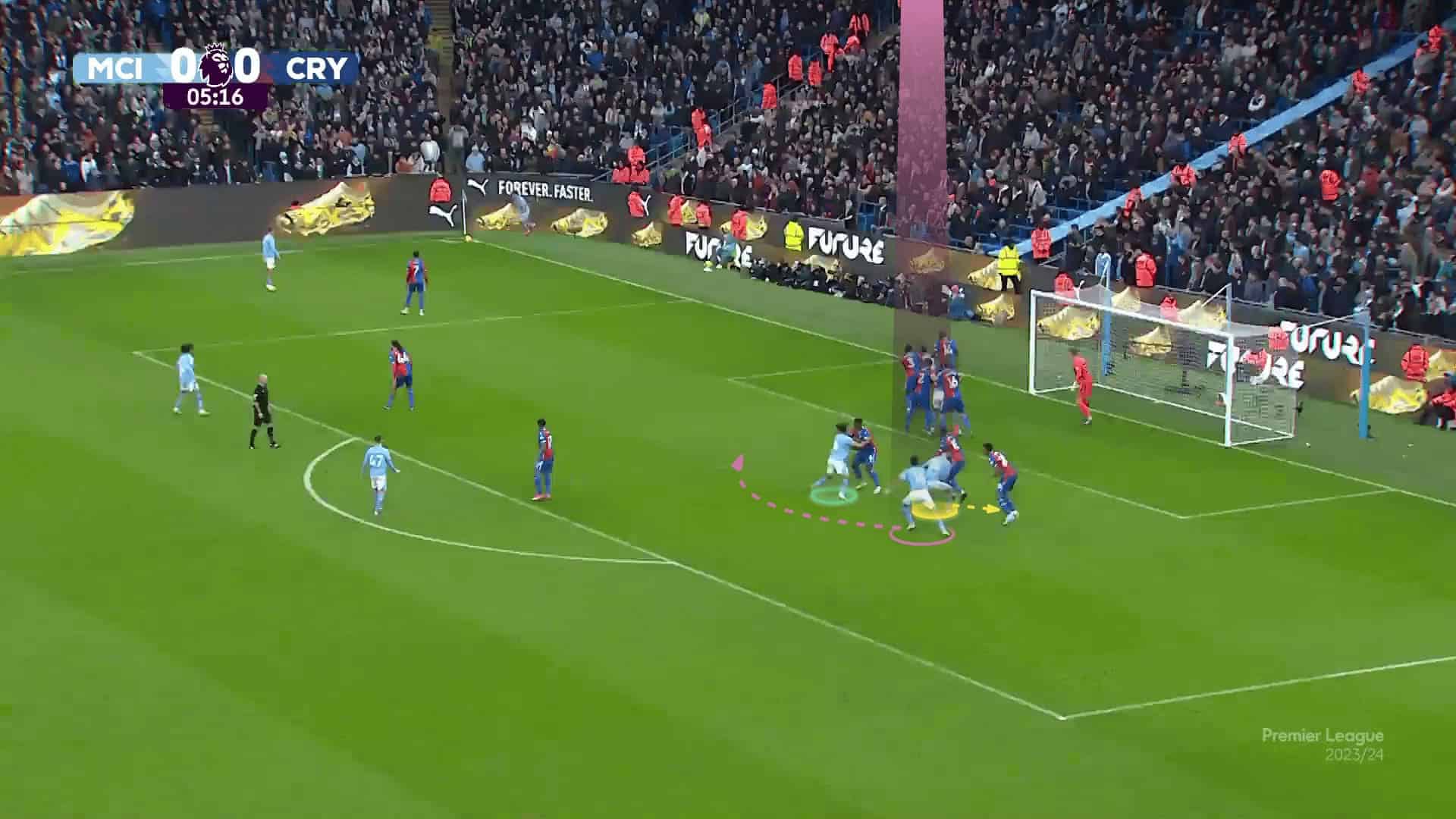
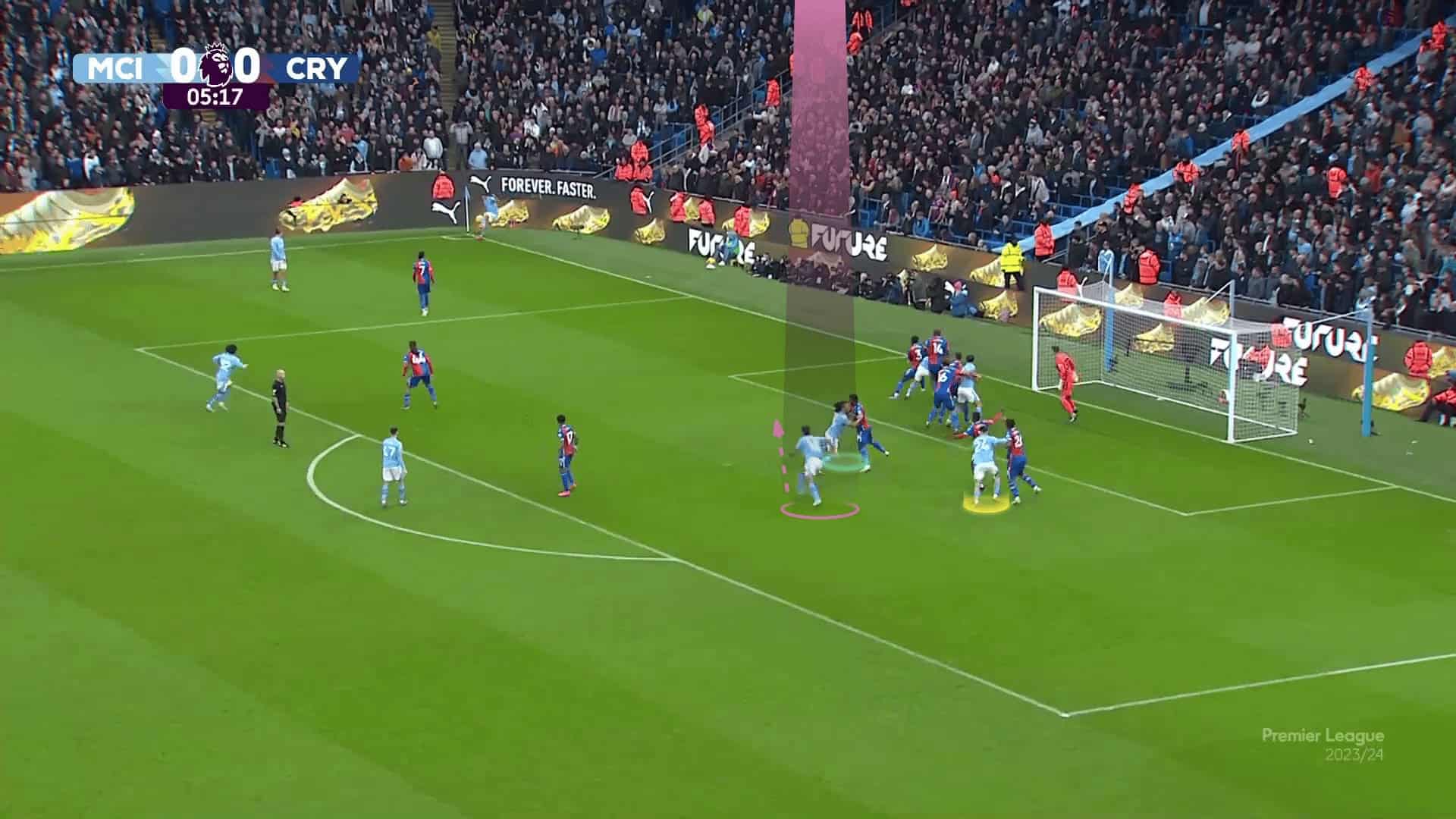
But he could push him to chase the targeted player because he saw the ball and all the movements necessary to perform the trick, so Man City turned to the third idea.
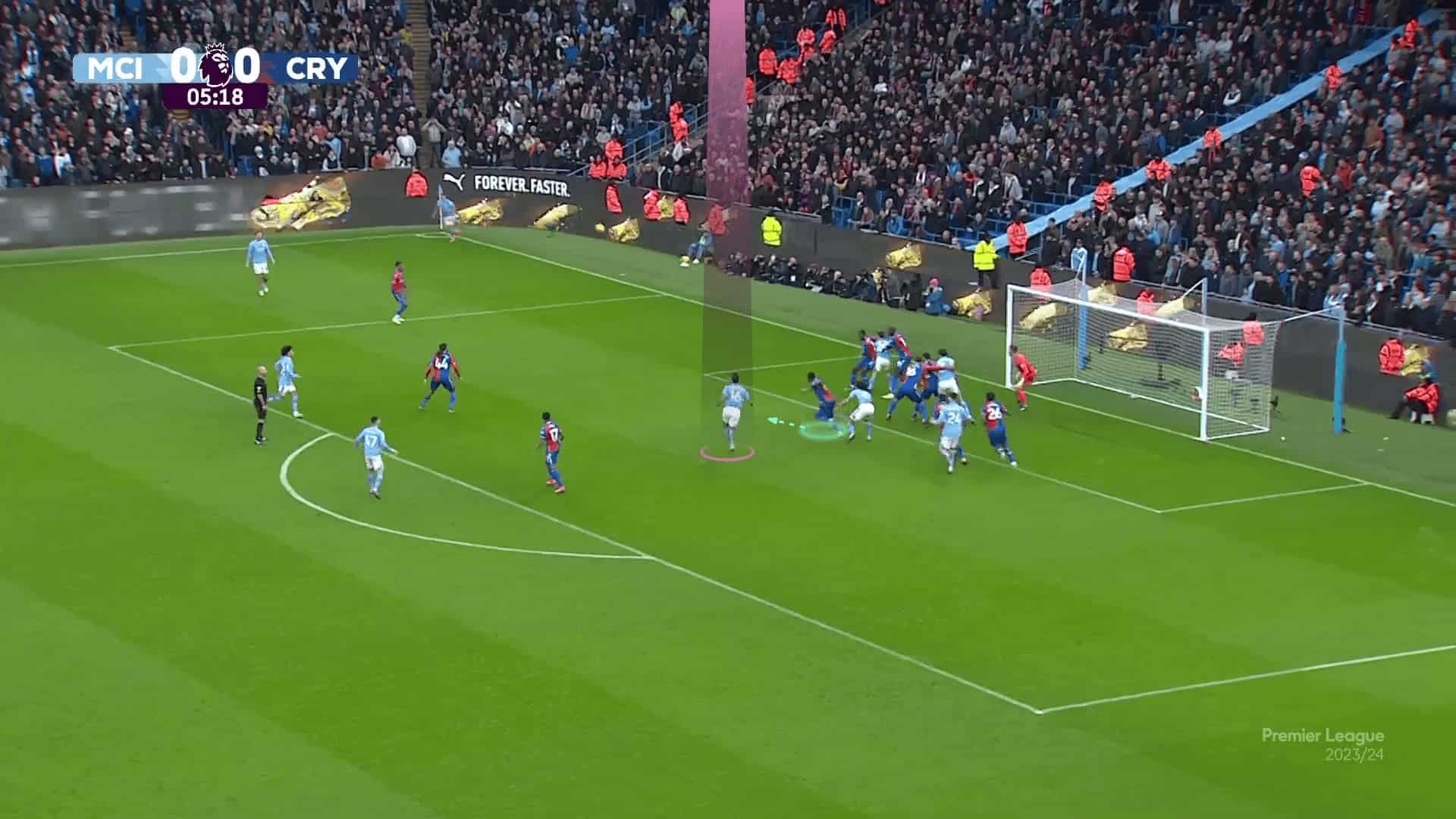
Combining Strategies: Orientation problems + screens
The third idea combines the two previous ideas, meaning that we will make the marker turn around and suddenly find himself against a screen, too.
Let’s clarify that!
In the first photo below, the change is evident by putting the pack more toward the near post, making the target player, Nathan Aké, the first one from the near side and will move to the far post, not the opposite as in the previous case.
Rodri, in this case, is the one who does the screen for his mate, so when Aké makes his curved run, his marker will turn around, giving his back to the ball, losing contact with it, and also finding Rodri against him as he turns around, as in the second photo below.
In the third photo, the third advantage is clear: the green man marker who cut the ball in the previous case needs to turn around to track the ball.
However, he will find the attacker in his back, preventing him, and if the targeted player’s marker can escape from Rodri, as happened, he will face orientation problems in his way to track the targeted player back.
In the end, Aké gets the ball while his mates frame the goal, waiting for the headed pass.
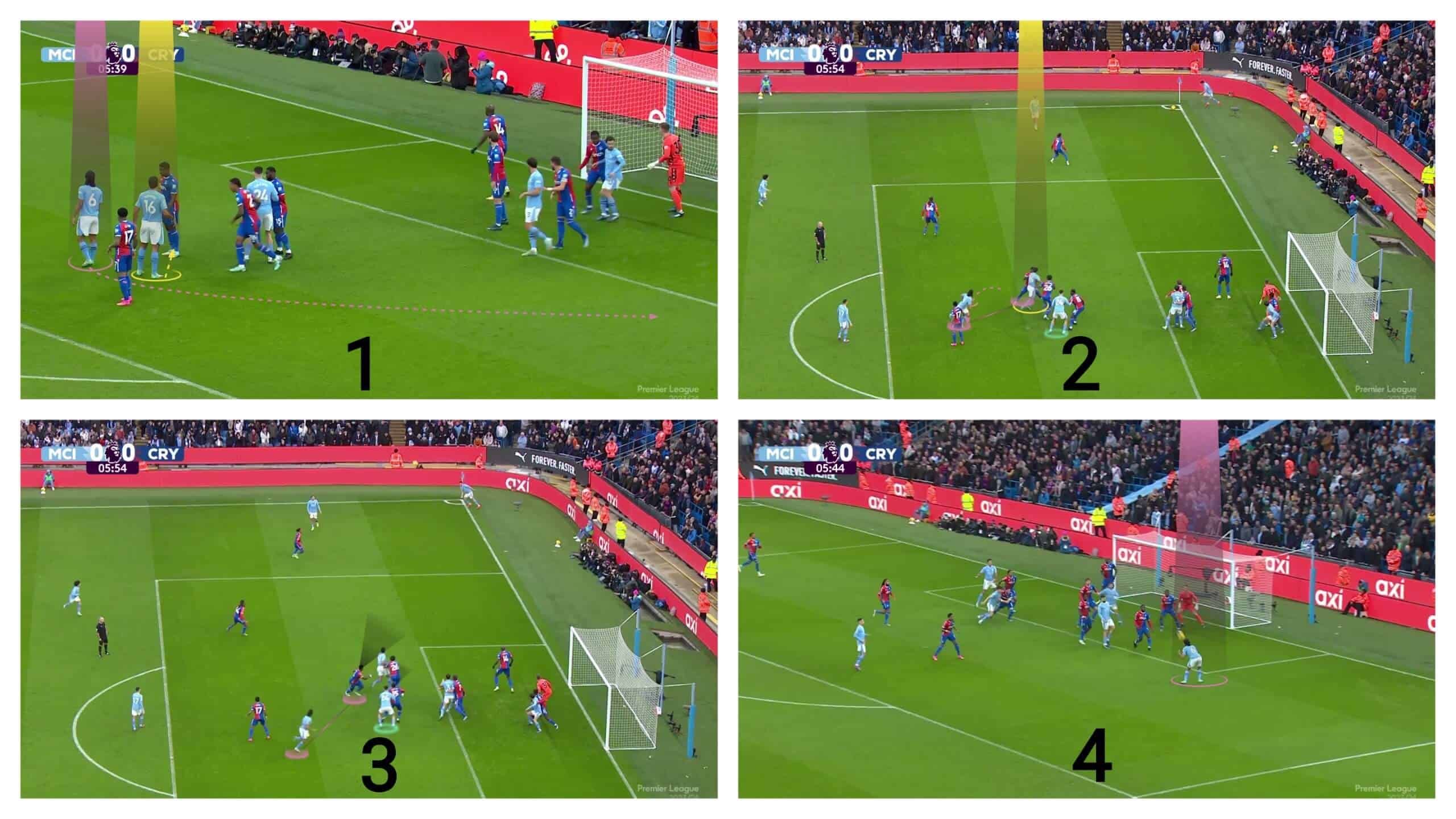
The ball reaches one of them and ends with a dangerous shot.
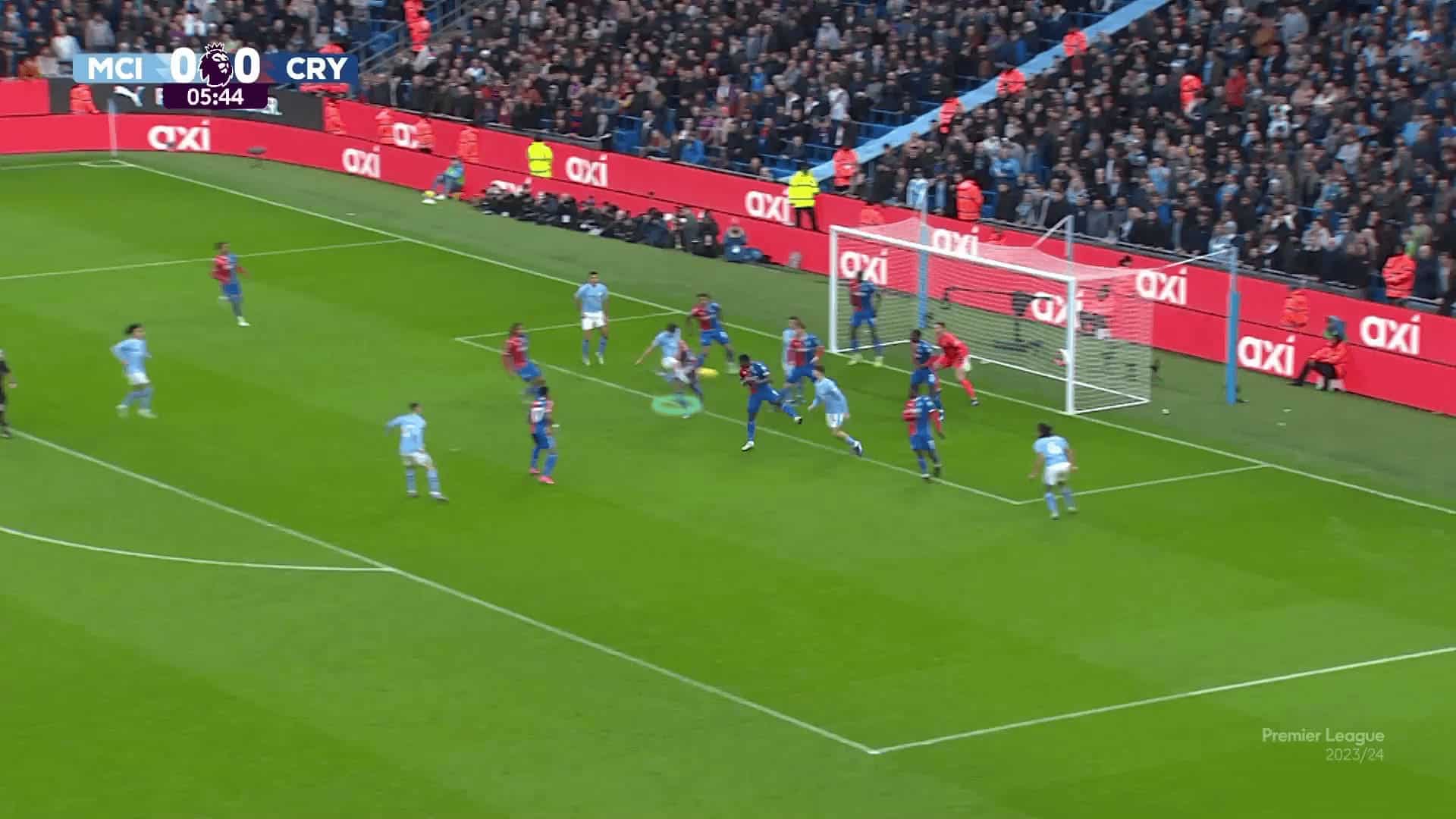
Many strategies depend on one of these strategies.
One of them is making the targeted player start in a far position, as in the first photo below, in which the targeted area is shown, and an attacker is ready to block the second zonal defender.
This puts the marker in a difficult question: going forward and sticking to the targeted player, which makes the ball behind him, facing orientation problems, or leaving a distance between him and the targeted player to make him stand in a good body shape to track the ball and the target player at the same time.
Here, the marker chooses the second choice, which leaves enough distance between him and the targeted player to exploit this separation without body contact at the taking-off, which makes him jump with his momentum, as in the second and third photos.
In the end, the targeted player hits the ball into the defender’s back.
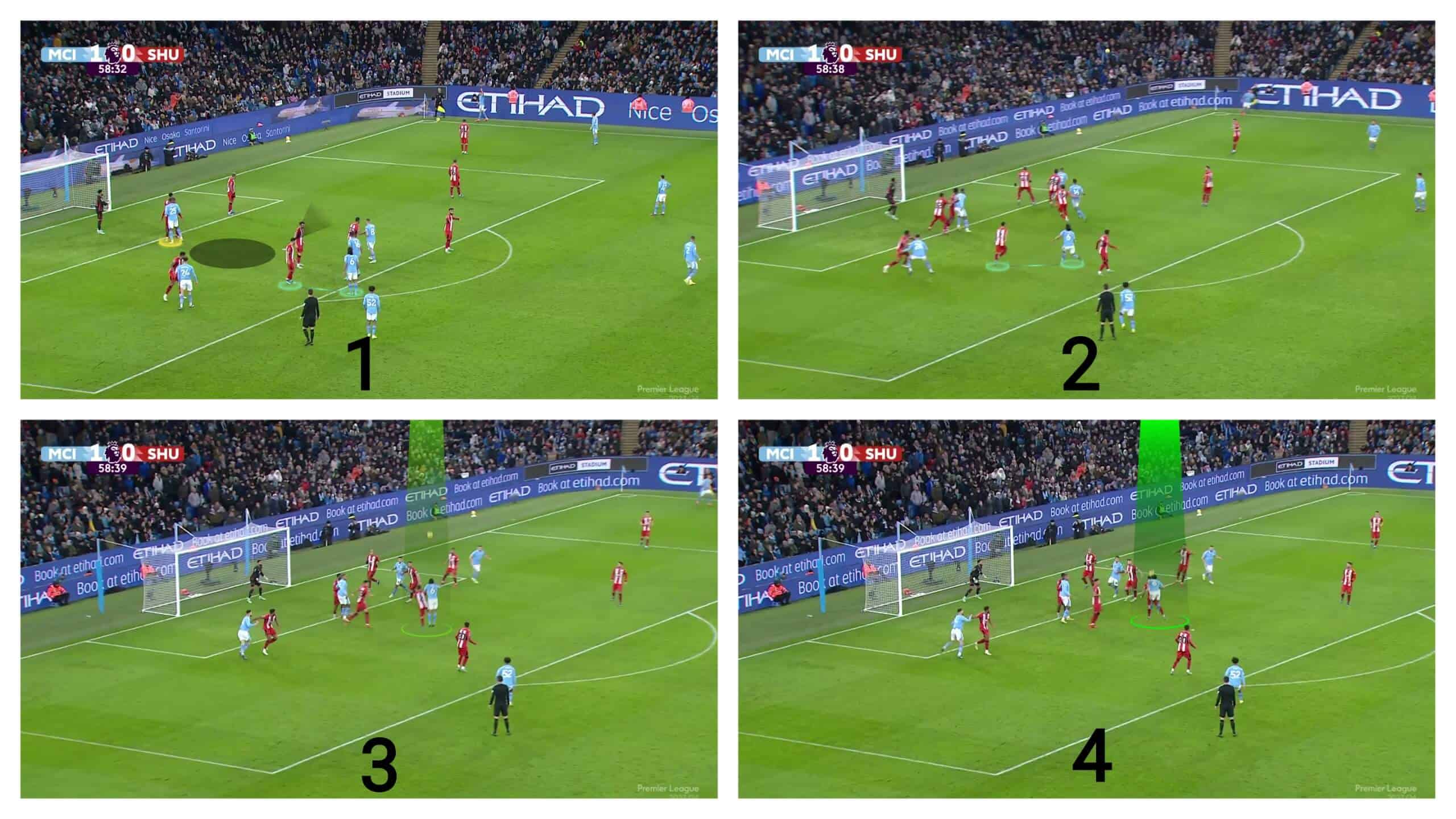
Short corners on Man-Marking Defenses
It becomes more difficult for teams who defend the short and rebound areas with the same man-marking reference, as in the case below.
In the first photo below, Sheffield United doesn’t leave a zonal rebound defender, which makes Brentford ask the player who stands on the rebound initially to drag the defender with him toward the second zonal defender to slow down him from going forward to free the rebound area from a player coming from the back suddenly, but the shot goes above the crossbar.
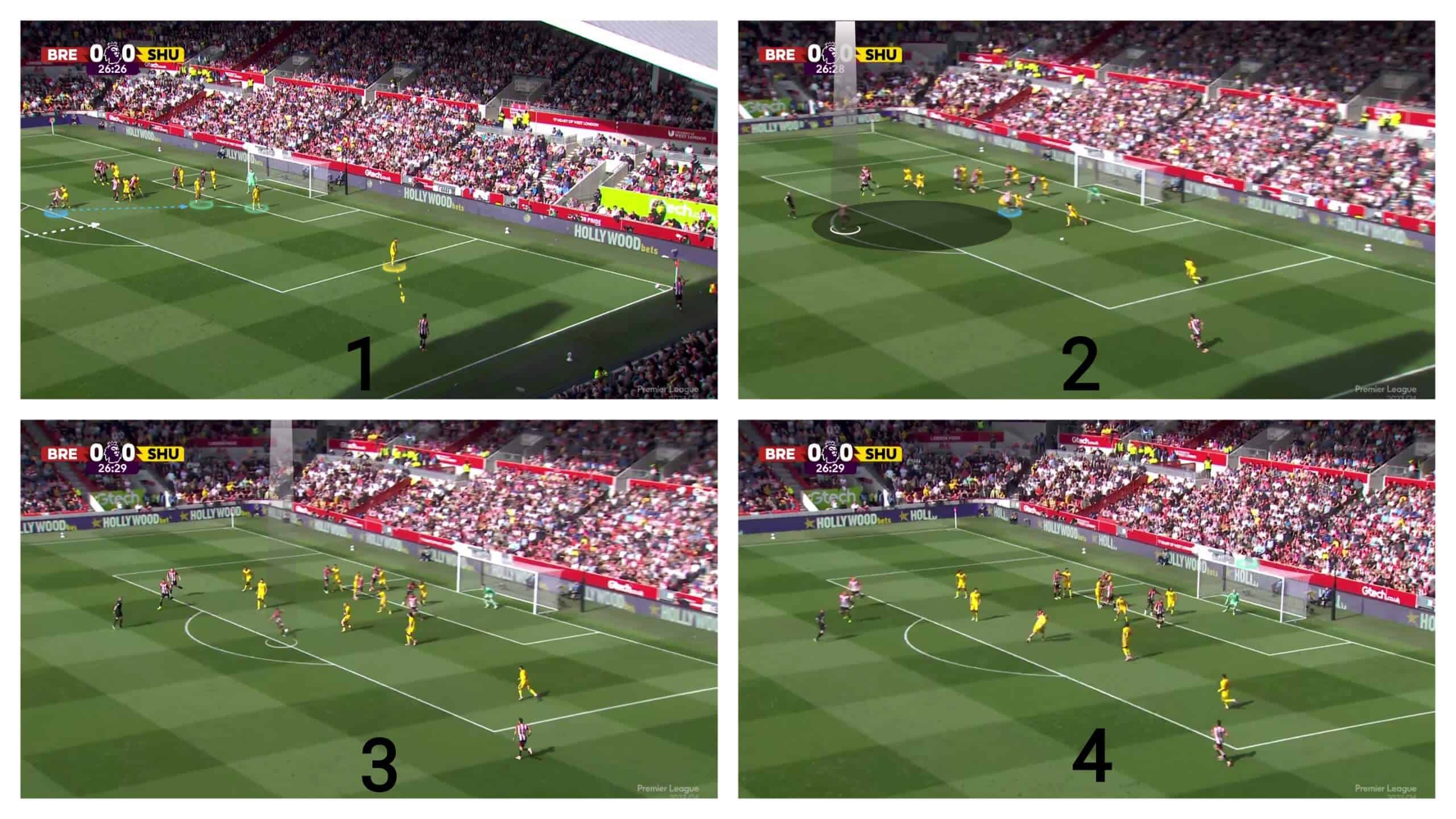
The second issue is that having not enough zonal defenders makes defending teams can’t be organised in a line to cover the goalmouth while trying to push up after the short pass, which leads to chaos, leaving gaps, especially on the far post, as in the case below.
In the photo below, Aston Villa try to exploit this by asking a player to come to the taker, pretending that he will be the new taker only, but he passes the ball to the old taker, and he does that trying not to attract an additional defender with him.
This makes the rebound green defender dragged with the green attacker standing on the edge of the box.
In contrast, the pink attacker drags his marker on the edge of the box to motivate that green rebound defender to leave the central area feeling safe because a defender stands in it, but he is a marker and can easily be dragged after that.
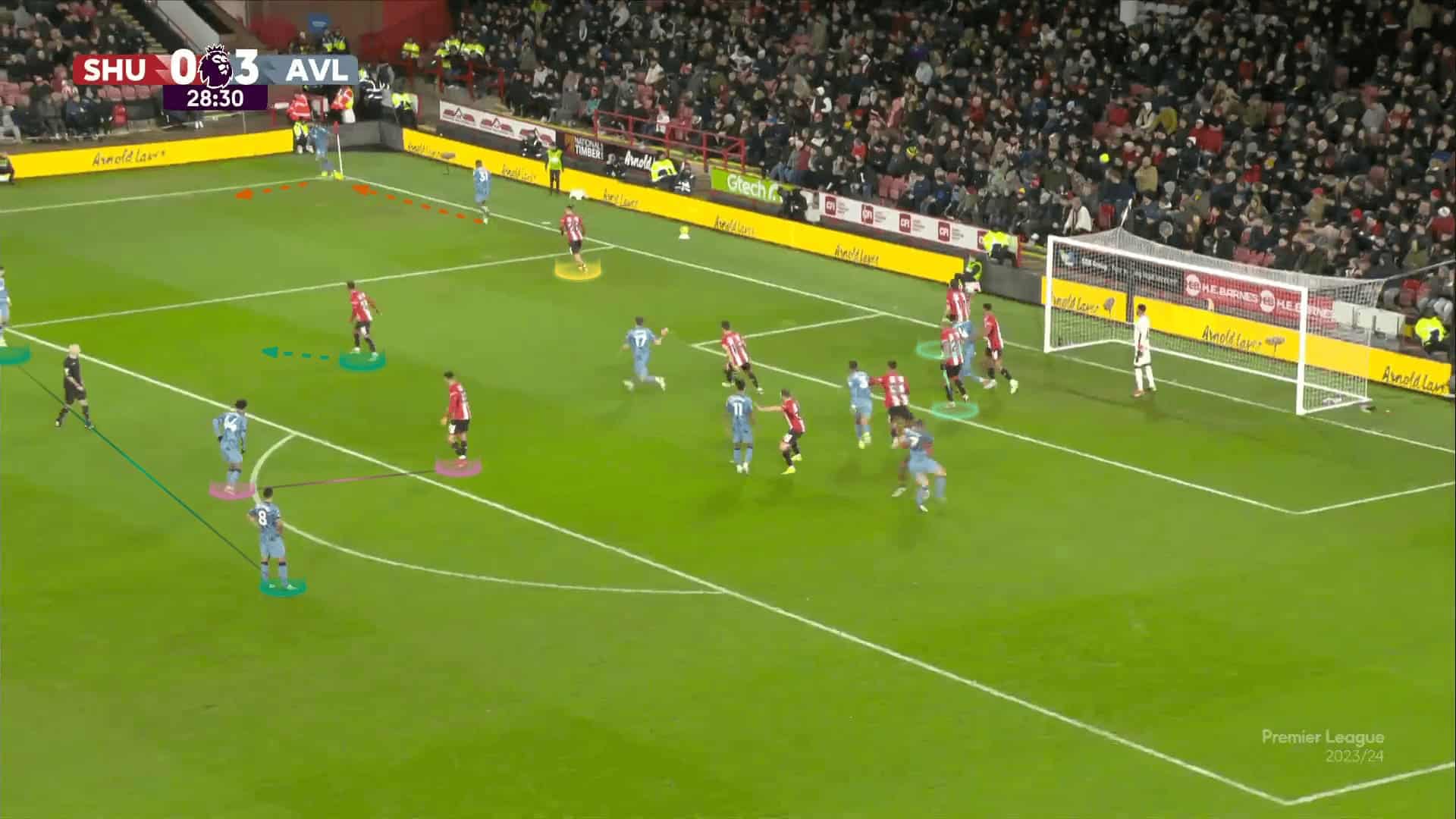
The targeted player is the second player on the edge of the box who pretends that he is waiting for the rebound and is free now.
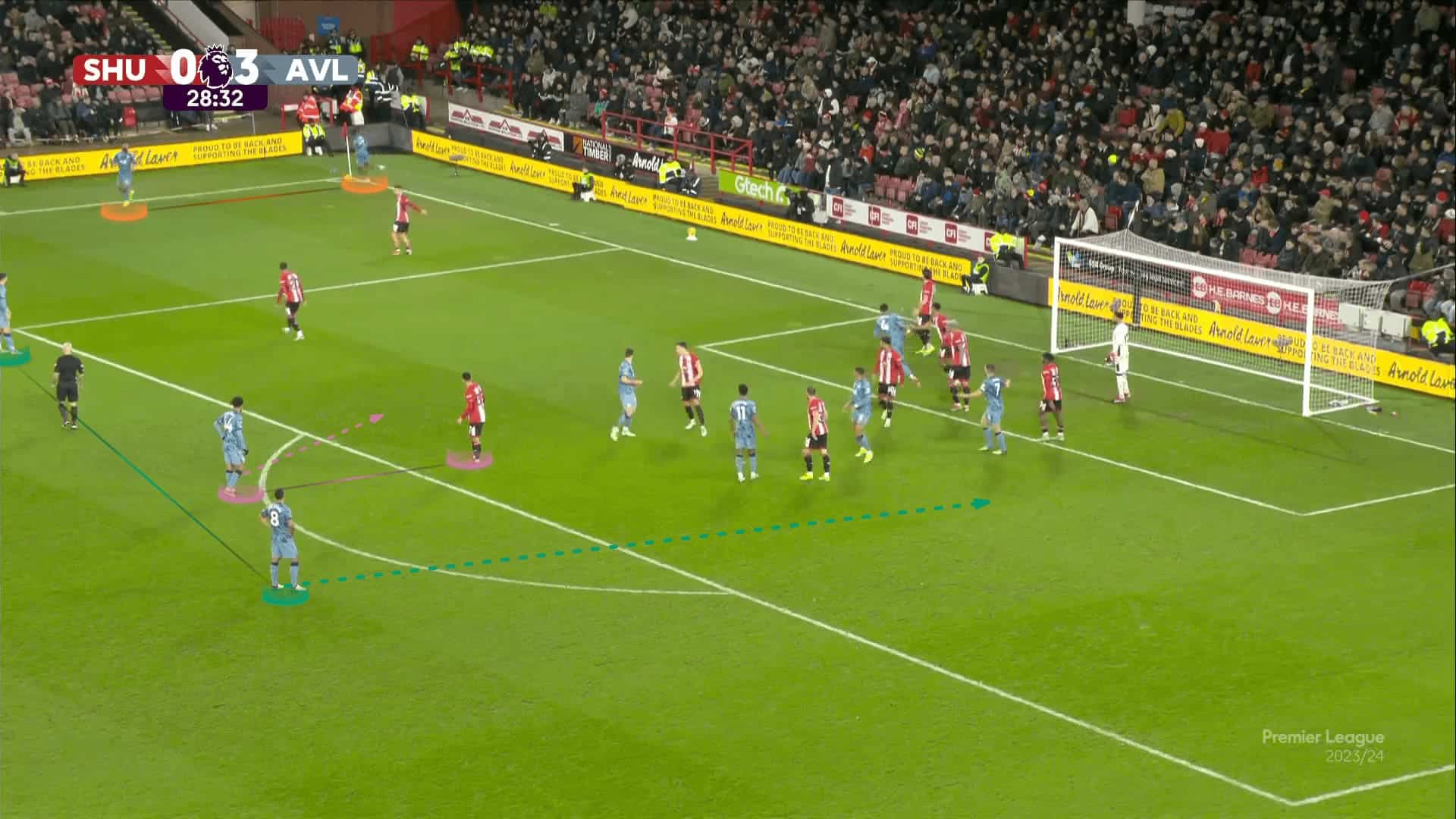
The second thing is asking the attacker to move toward the near post surrounding the two zonal defenders, preventing them from getting back to the far post.
Some movements even make the two zonal defenders shift more toward the near post
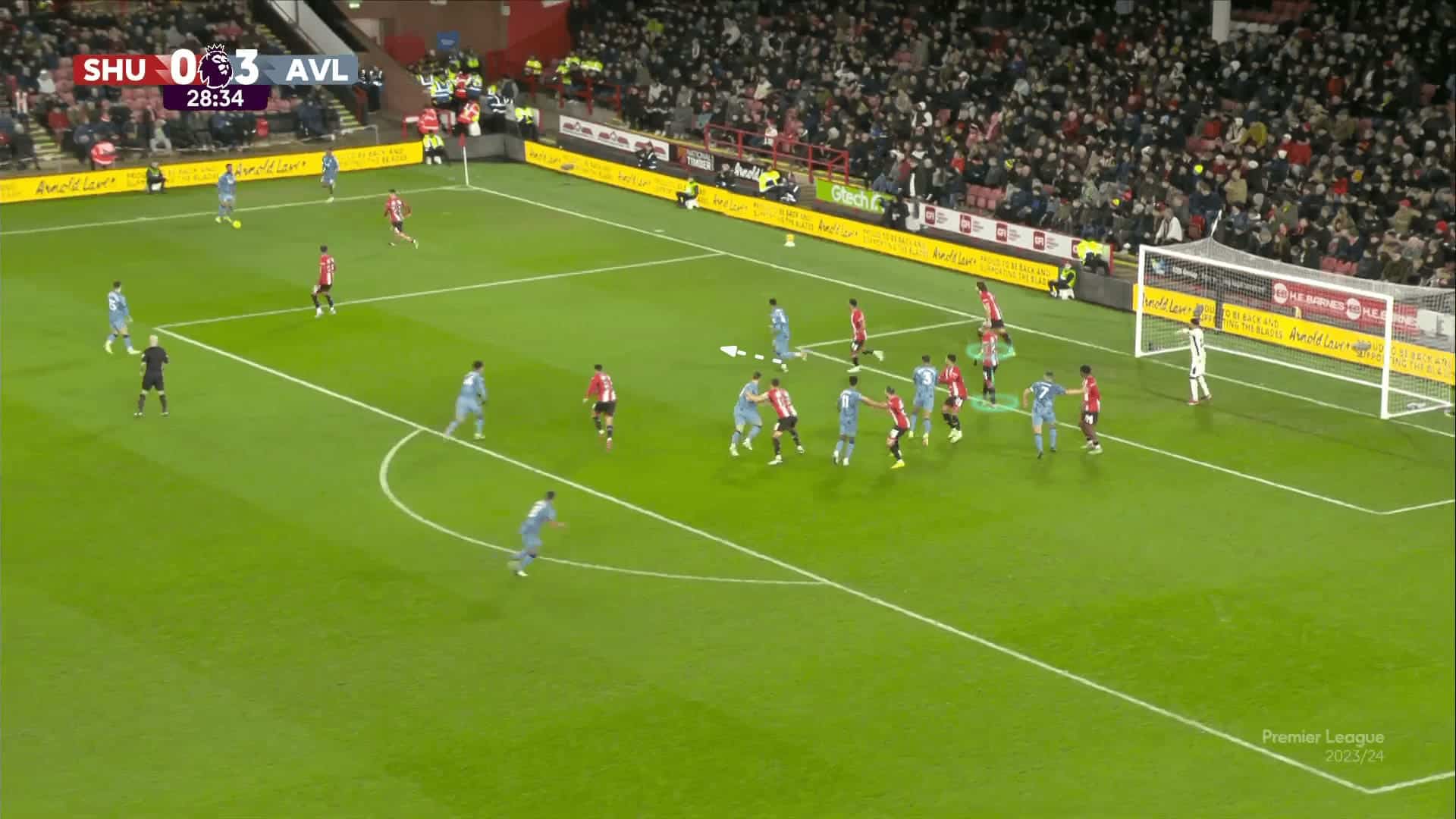
In the end, the plan works, but a defender saves the ball intelligently at the last moment, as in the three following photos.
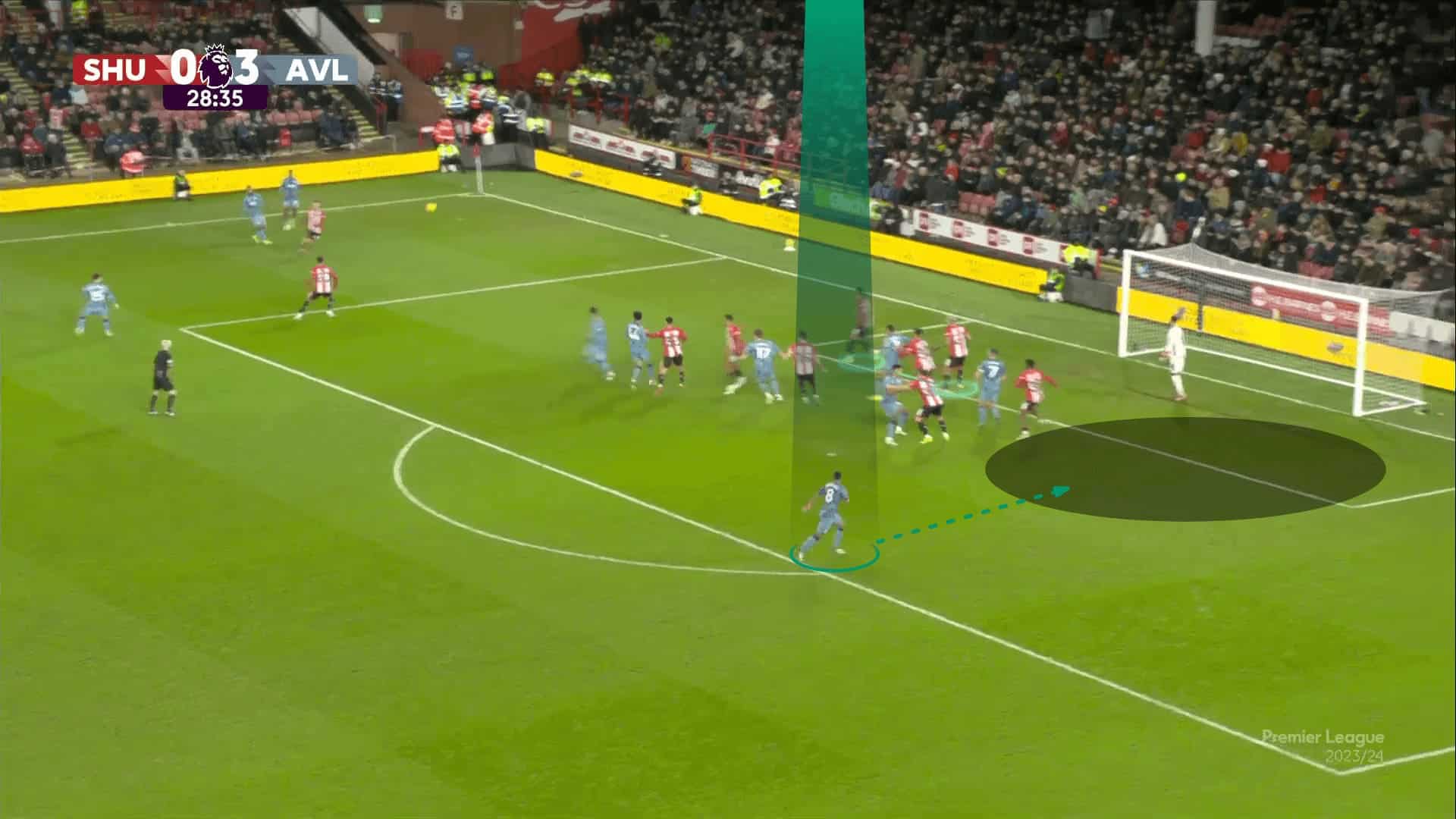
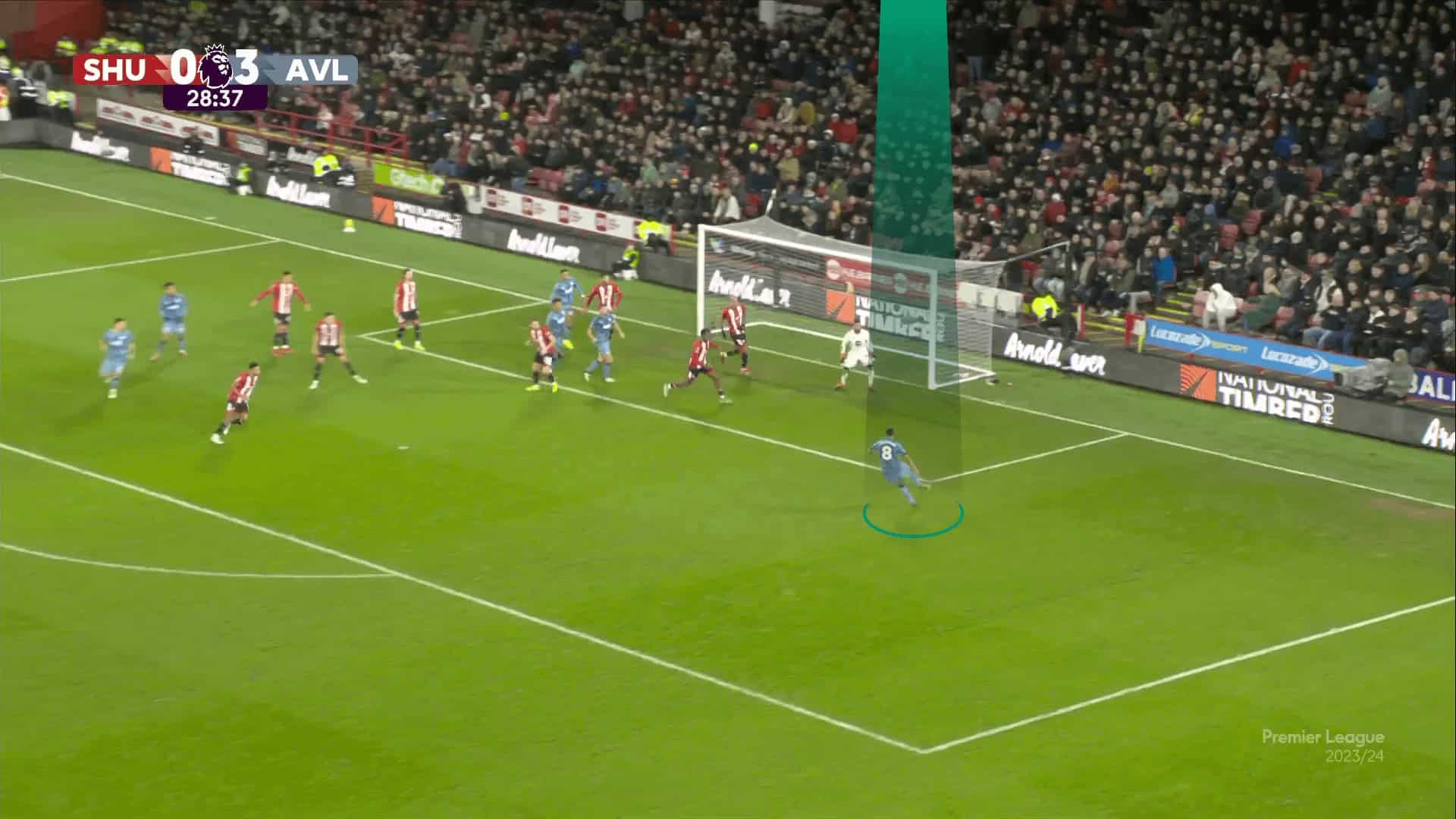
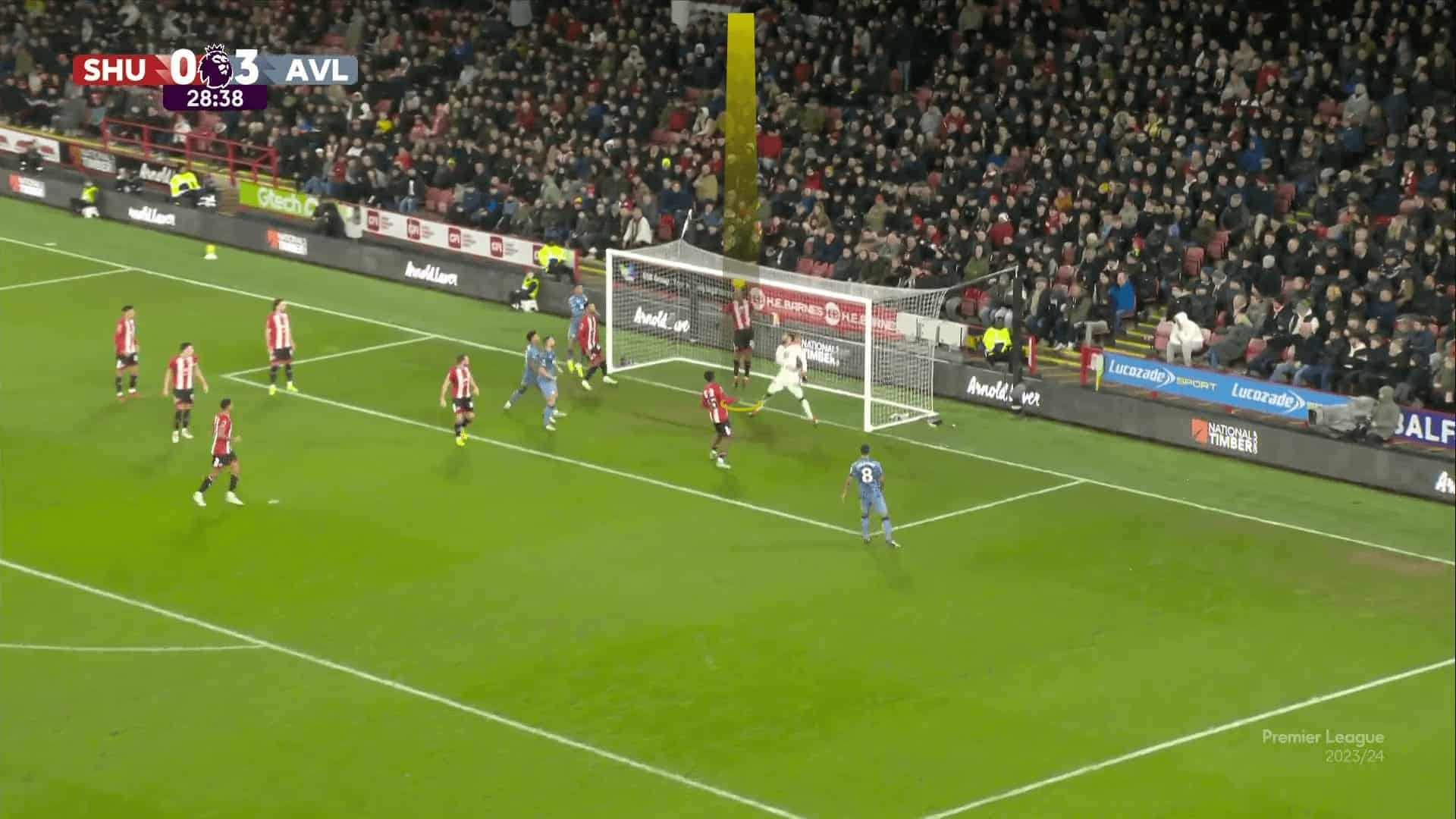
You can notice the difference in the case of having more zonal defenders like Liverpool in the case below.
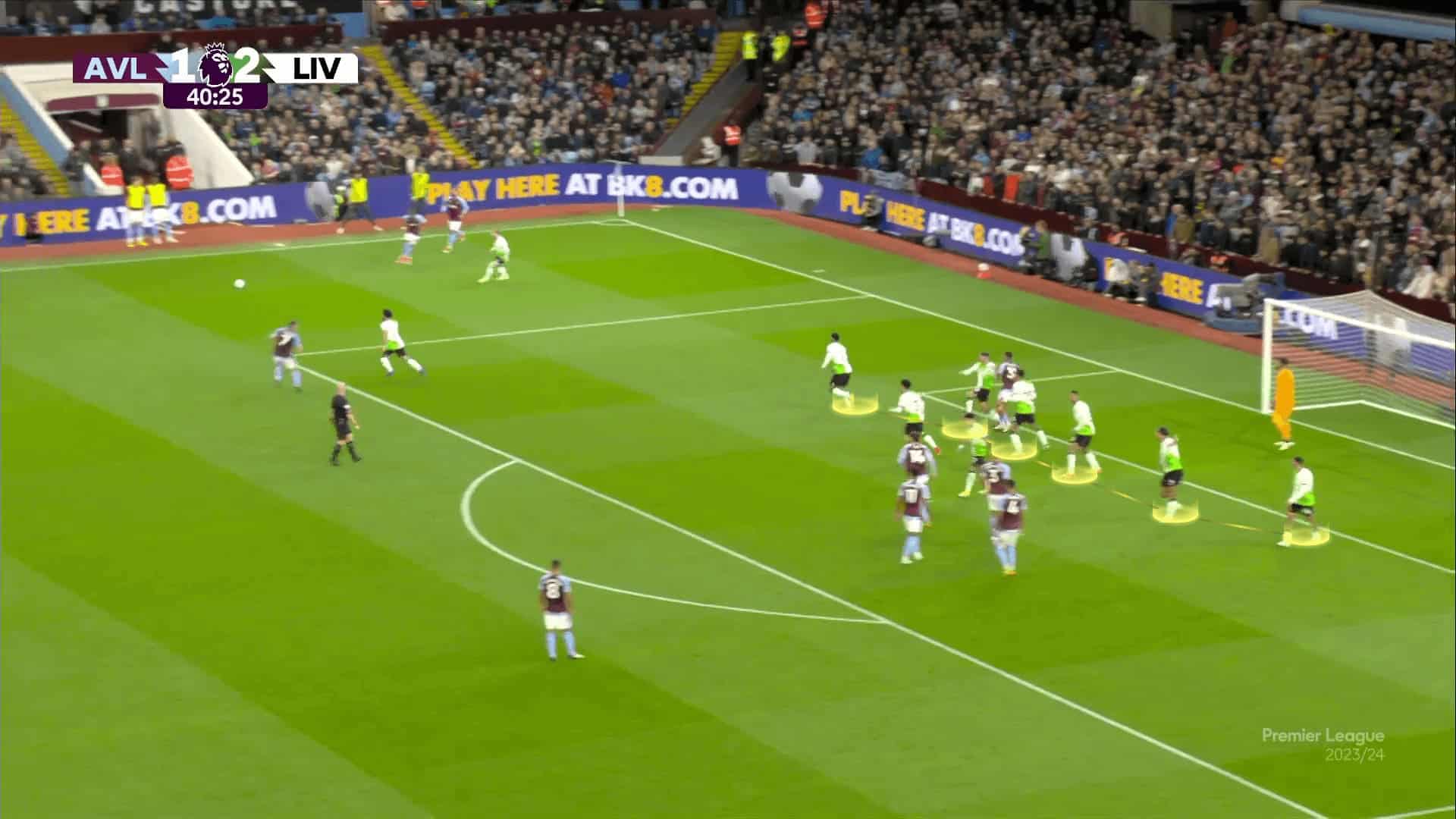
Conclusion
In this analysis, we have discussed the reasons behind the scarcity of using the ‘man-marking’ defending style during corners in the Premier League and whether it is on the path to extinction.
In this set-piece analysis, we have also shown the different strategies that the Premier League elite teams used against teams that still follow the traditional man-marking system.






Comments